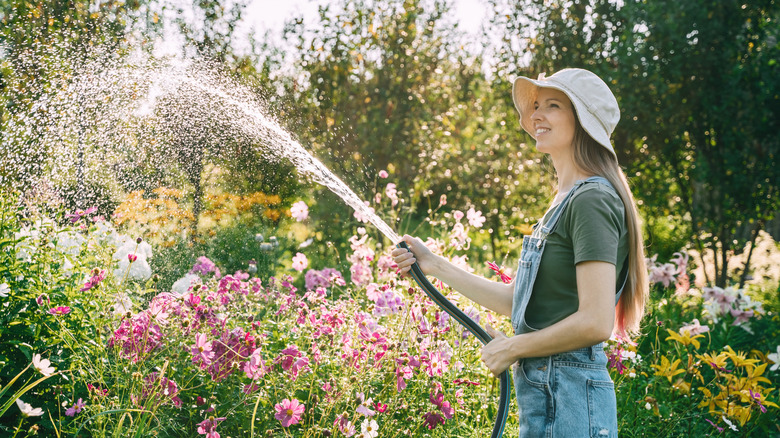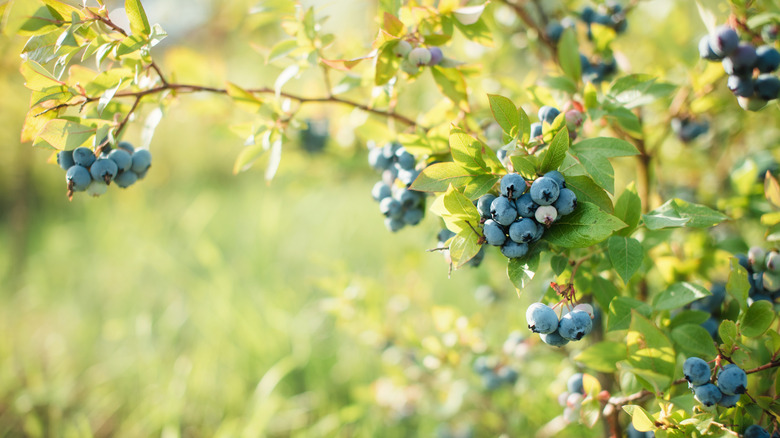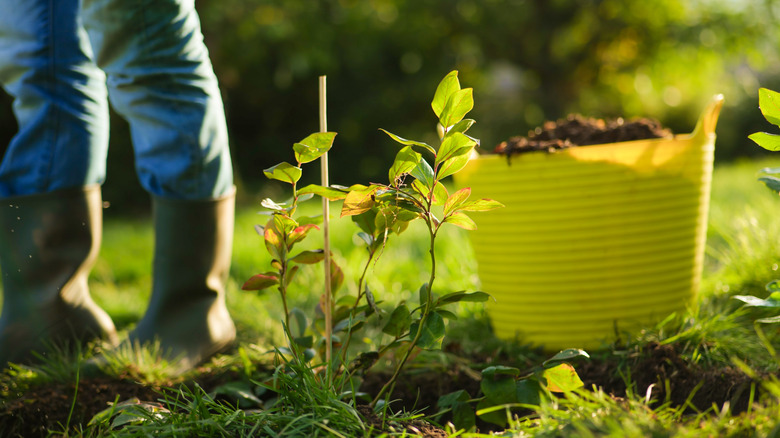The Popular Garden Shrub You May Be Overwatering And How To Fix It
Watering the garden is a necessary chore, and in the heat of summer, it may need to be done more frequently. The right amount of water depends on the plant: Some species need extra water during hot, dry weather, while others are more drought tolerant and don't require additional irrigation. Watering properly is also important: Watering at the roots is usually recommended over watering from the top or using a sprinkler, but too much water may cause root rot in some plants. While most fruits and vegetables require a lot of water, there's one fruiting shrub that's easy to overwater without realizing it: your blueberry bushes.
Blueberries are easy to care for. You can even grow blueberries in containers, especially some of the new dwarf hybrid varieties, sometimes called "patio blueberries". They do require some pruning, but don't need a lot of fertilizer — in fact, too much fertilizer is bad for them — and generally don't have to be sprayed for pests or diseases. They're cold hardy and also self-fertile (althought it's recommended you plant more than one variety for optimal fruit production). Blueberries have three basic growing requirements: full sun, acidic soil, and getting 1 to 2 inches of water per week in the growing season.
But despite their need for ample water, you should take care not to overwater blueberry shrubs, since doing so can affect their growth and fruit production. There are a few things to look for to know if your blueberries are overwatered or waterlogged. In addition to paying attention to these signs, there are some very straightforward approaches to addressing this problem to keep your blueberry shrubs thriving and healthy.
How much water blueberries need, and signs of overwatering
Blueberries may be a relatively easy-care fruit plant, but it takes some effort and knowledge to water them properly. They like to be kept moist, but overwatering can lead to serious problems, including root rot or fungal disease, as well as a general lack of vitality. The main reason overwatering affects blueberry growth has to do with the large volume of water displacing oxygen from the soil, which affects the plant's health in various ways.
There are several signs to watch for that may indicate your blueberries are getting too much water. These include wilting, slow growth, or the leaves remaining small. Wilting means the leaves look droopy on the branch. Slow growth means the plant doesn't put on size at a normal rate; that said, blueberry shrubs are normally slow growers, so it may be hard to tell what a normal growth rate is. Also, note that smaller-than-normal foliage may also indicate a mineral deficiency in the soil.
If your blueberry is showing any of these signs, you should immediately reduce your watering frequency to try and avert the possibility of root rot. This condition is caused by bacteria that are more prevalent in poorly drained soil, where there is constant moisture, and it may eventually kill your blueberry shrubs. Also, consider using the tips below to try and regulate water absorption and get your blueberries back to good health. If the roots are already rotted, you may have to replace your plants.
How to keep your blueberries from getting waterlogged
Apart from reducing irrigation frequency, you can keep your blueberries from getting too much water by improving drainage. That said, once the shrubs are already planted in the ground, this can be tricky. If the plants are still fairly young, you can dig them up and replant them with soil amendments to improve drainage; do this in early spring before new growth emerges. You can also apply lightweight natural mulch (like pine bark mulch, which has slight acidity and is perfect for blueberries) to help nurture soil and regulate water absorption. Mulching is best done in late spring, and it will also help control summer season weeds.
Adding some organic matter (like compost or shredded leaves) as a top dressing is also a good method for improving soil drainage and texture, especially if you have heavy clay soil. Do this in late summer (July to September), then add another light layer of pine bark mulch in autumn. As the soil absorbs nutrients from organic matter, its content of beneficial microorganisms increases, improving soil texture and drainage and helping prevent your blueberry shrubs from getting waterlogged.
If your blueberries are growing in containers, you can improve their drainage in various ways to help insure they don't get too waterlogged. Make sure the soil is loose and airy: a half-and-half mixture of good quality potting soil and peat moss is perfect for blueberries, which grow best in a well-draining, acidic soil. Placing your containers on top of bricks instead of on the ground, patio, or sidewalk, also helps drainage.


